
views
X
Research source
Choosing Your Pen Name

Brainstorm possibilities. If you don't already have a pen name in mind, come up with some possibilities that you can evaluate. You might want to choose a pen name that is related to your real name, or that reflects an event that happened in your life. Keep in mind that the pen name you choose will become a part of you. There will be people who know you and address you by that name, so it needs to be something with which you feel comfortable. The pen name you choose may depend to some extent on your reasons for choosing it. For example, if you write primarily literary fiction but want to write romance or erotic fiction under a different name, your pen name might have a flowery, romantic bent. When considering possible pen names, you also may want to keep in mind how anonymous you want to be. If you're not terribly concerned about people discovering your true identity, you might choose your middle name combined with a variation of your last name. However, if you want to take every step to ensure your real identity is undetectable, you want to pick a name as far removed from your legal name, or the names of those close to you, as possible.

Avoid famous names. Search carefully to make sure the pen name you've chosen isn't the name of a celebrity or historical figure. A pen name shared by a famous person not only creates a likelihood of confusion but could get you into legal trouble for identity theft. Conduct initial searches of possible pen names online to find out if they're associated with a famous person you may not know. Keep in mind you're not just looking for celebrities, but also people who are well-known or important figures in their fields. Small differences probably won't make much difference if the famous person has a significant and renowned profile. For example, if you've chosen "Maria De La Curie" as a possible pen name, it may be too close to the name of the famous scientist Marie Curie to work for you. Some last names, such as Hilton or Trump, are too well associated with famous people to work as a pen name, even if the first name is significantly different.

Make sure your chosen name is available. Once you've chosen a good name, search for it on the internet and in various databases to confirm someone else isn't already using it. If there's already an author with the same name, readers will have difficulty distinguishing between you and you could run into problems trying to register the name. Bookstore websites are a good place to start. Search your pen name as an author name and see what comes up. If someone else is already using the same name, you should consider choosing something different. The U.S. Copyright Office has a searchable database of registered copyrights on its website that you can use. If the name comes up, this means other copyrighted works are registered under that name. Don't forget to do a general online search for the name, which could turn up social media accounts and other stories involving people with the same name. As long as the name isn't shared by someone who also is a writer, your pen name may be good to go. However, you want to consider your ability to set up social media accounts under that name if it's a common name that others are using. You also want to carefully review any news articles that come up when you search your pen name. Pretend you're a reader trying to find out more information about your favorite author. Even if articles aren't really you, one of your readers wouldn't necessarily know that. For example, if you search your chosen name and find out a notorious killer in Michigan shares that same name, you may want to go with something else – even if you have never visited the state. The risk of confusion may not be worth it.
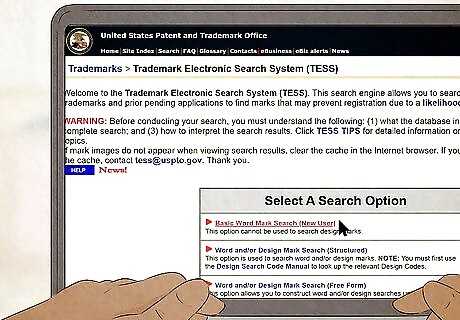
Conduct a trademark search. If you're planning on trademarking your chosen pen name, it's a good idea to go ahead and do a trademark search before you settle on the name. You won't be able to register it if someone else already has. The U.S. Patent and Trademark Office (USPTO) has a searchable database of active and pending registrations on its website. In addition to searching for the specific pen name you've chosen, you also want to search for similar names that could easily be confused with yours. Film, television, and video game companies frequently register trademarks for current and potential character names, particularly in popular and long-running franchises. If your name comes up under one of these registrations, you'll want to pick something different. Keep in mind that if your name comes up in the USPTO database, you probably want to choose a different name even if you don't plan on registering a trademark in the name. If a trademark is already registered by someone else, you run the risk of getting sued for trademark infringement if you use it.

Establish accounts under your pen name. After you've cleared your chosen name and confirmed it's available for you to use, go ahead and create an email address under your pen name and reserve the domain. You can claim a domain name relatively cheaply, even if you don't plan on creating a website for your pen name yet. Create an email address using a free email service, or get an email address associated with your pen name's domain through the company with which you registered the domain name. Go ahead and claim social media account names on popular social media sites you think you might use. You'll need social media accounts to market and publicize your writing, and it's a good idea to get the initial set-up out of the way even if you don't think you'll need them for a while.
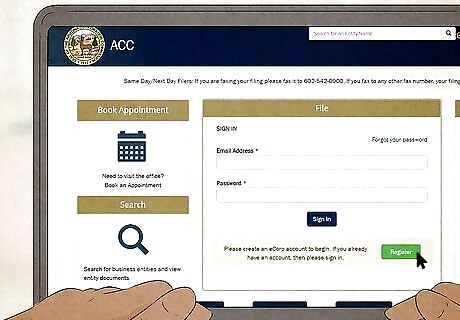
Consider adding a layer of protection. If your purpose in using a pen name is to keep your real identity from being discovered, you may want to consider creating a corporation or LLC to use for registrations that will become a matter of public record. Arizona is the only state that allows the creation of an anonymous LLC, and the process is rather complex and requires hiring an attorney. However, even if the LLC is in your name, anyone trying to discover your identity would have to find the LLC documents in the database of the state in which you formed your LLC. It's not a fool-proof way of concealing your identity, but it does provide an extra layer of protection. Otherwise, your legal name would be clearly displayed on any documents for copyright or trademark registration, which are public records.
Registering Your Copyright

Confirm your eligibility for copyright registration. Since you can't copyright single words or short phrases, you won't be able to register a copyright in the pen name itself. However, you can register your copyright in the works you create under that name. Copyright gives you the exclusive rights to reproduce and distribute your written work. Keep in mind that copyright doesn't protect ideas, only completed creative work – so you have to actually complete your story or other writing before it will be eligible for copyright. You have copyright protection from the moment you create your work. However, you must register your copyright with the U.S. Copyright Office if you want to be able to sue people who infringe your copyright.
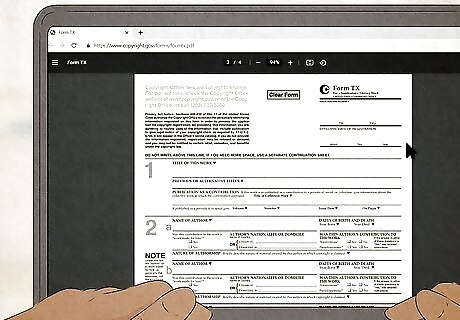
Download an application. The U.S. Copyright Office has a copy of the registration application on its website, which you can fill out online, or download and print it if you prefer to mail a paper application. If you fill out your registration application online, you'll have the ability to check the status of your application at any time. You'll also pay a lower registration fee.

Decide whether you want to reveal your real name. The length of time you will enjoy copyright protection depends on whether you register it as a pseudonymous work or register it in your legal name and include the pen name you wrote under. The application requires you to provide the title of your work, the type of work it is, and the date it was created. You also must include information about the author of the work. This is the portion of the application in which you must make a decision whether to register the copyright in the work under your real name. If you want to be identified by your real name in Copyright Office records, check the box marked "pseudonymous" and provide your pen name where required. You then will list your real name as the copyright claimant. If you don't want to be identified by your real name in Copyright Office records, use your pen name as the copyright claimant. Make sure you still check the "pseudonymous" box. Copyrights registered under pen names only last for 95 years from publication or 120 years from creation, whichever comes first. However, if you use your legal name as the claimant, your copyright protection will last for your entire life plus 70 years. If you've created a corporation or LLC and want to register the copyright in the name of that entity, the copyright term will be the same as if you'd registered under your pen name.
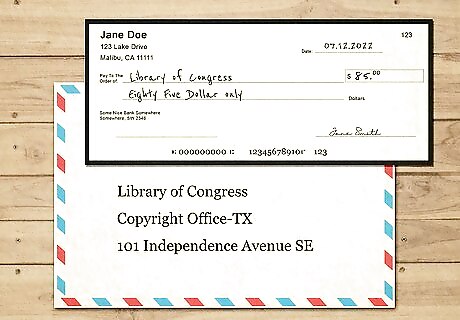
Submit your application. Once you've completed your application, you can either submit it online or mail it to the U.S. Copyright Office along with the required fees. The amount of registration fees you'll have to pay depends on the type of work you're registering and how you file your application. For example, if you're registering a single work online, you only have to pay $35 in registration fees. However, if you send a paper application through the mail, you'd have to pay $85. If you want, you can register several separate works at the same time as a series. Registering a series entails paying a higher registration fee than that required for single works.

Send deposit copies. You must include copies of the work that is the subject of your registration application. Copies are required for deposit in the U.S. Copyright Office as well as for use by the Library of Congress. When completing and filing your registration application online, you have the option of filing electronic copies of the work, which can save you a lot of time and money – especially if you're registering copyright in an extensive manuscript several hundred pages long. Keep in mind that in some cases the Copyright Office still requires you to send a physical copy of the work, even if you've already submitted an electronic copy.
Registering Your Trademark

Consider hiring an attorney. Although you don't technically need an attorney to get trademark protection, trademark applications can be complicated. Hiring a licensed and experienced trademark attorney will help smooth the process. An experienced trademark attorney will have familiarity with the USPTO and its application process, which can prevent you from making mistakes on your application that result in its denial. Keep in mind that your application will be reviewed by a trademark attorney who works for the USPTO. However, that attorney does not represent you and can't give you any legal advice on your application. Since an attorney will be reviewing your application, it only makes sense to have someone on your side to help you complete it.

Complete your trademark application. Your application tells the USPTO the name you want to register for trademark protection, as well as where and how you intend to use it. There are two basic types of trademark applications, those based on actual use and those based on intent to use. Applications based on intent to use tend to be more complex than applications based on actual use, and require you to fill out additional forms. Your application must describe the formats in which you'll use your pen name, and the goods or services to which it will apply. This involves selecting commercial classes, and you want to be forward-thinking in the categories you choose. Keep in mind that your business as an author may grow, and you may have opportunities above and beyond simply writing books or stories that involve the use of your pen name.
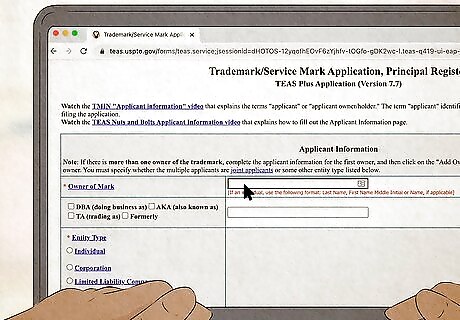
File your trademark application. The USPTO allows trademark applications to be filed electronically on its website. Your pending application will be added to the searchable database and the information in it becomes a matter of public record. You must pay filing fees of at least $375 when you file your trademark application. If you want trademark protection in multiple commercial classes, you'll have to pay higher fees.

Work with your application examiner. Your application will be assigned to one of the trademark attorneys who work for the USPTO. He or she will examine your application and determine whether it can be approved as is or additional information is needed. Keep in mind the application examination can take several months to complete. You can check the status of your application online as well as update your contact information as necessary while your application is pending. If the examining attorney approves your trademark, its pending registration will be advertised in the USPTO's official gazette. Anyone opposed to registration of your trademark has 30 days from the date of publication to file a notice of opposition. If no one opposes your trademark, the USPTO issues your registration certificate after the 30-day notice period is up.

Use your pen name consistently. Once registered, you must file periodic documents and pay the required fees to keep your registration active. Your trademark protection will last indefinitely as long as you maintain your mark by using it continuously for the purposes listed. Having your pen name trademarked doesn't mean other people can't use it at all. There may be people whose legal given name is your pen name, and they aren't infringing your trademark. However, trademark registration does mean you can prevent someone else from using the same name as their pen name. To enforce your trademark, you must bring a lawsuit in federal court. The USPTO does not monitor or enforce trademarks – registration only gives you the right to file a lawsuit. If you were to file an infringement lawsuit, you would enjoy a legal presumption that you are the rightful owner of the name.




















Comments
0 comment